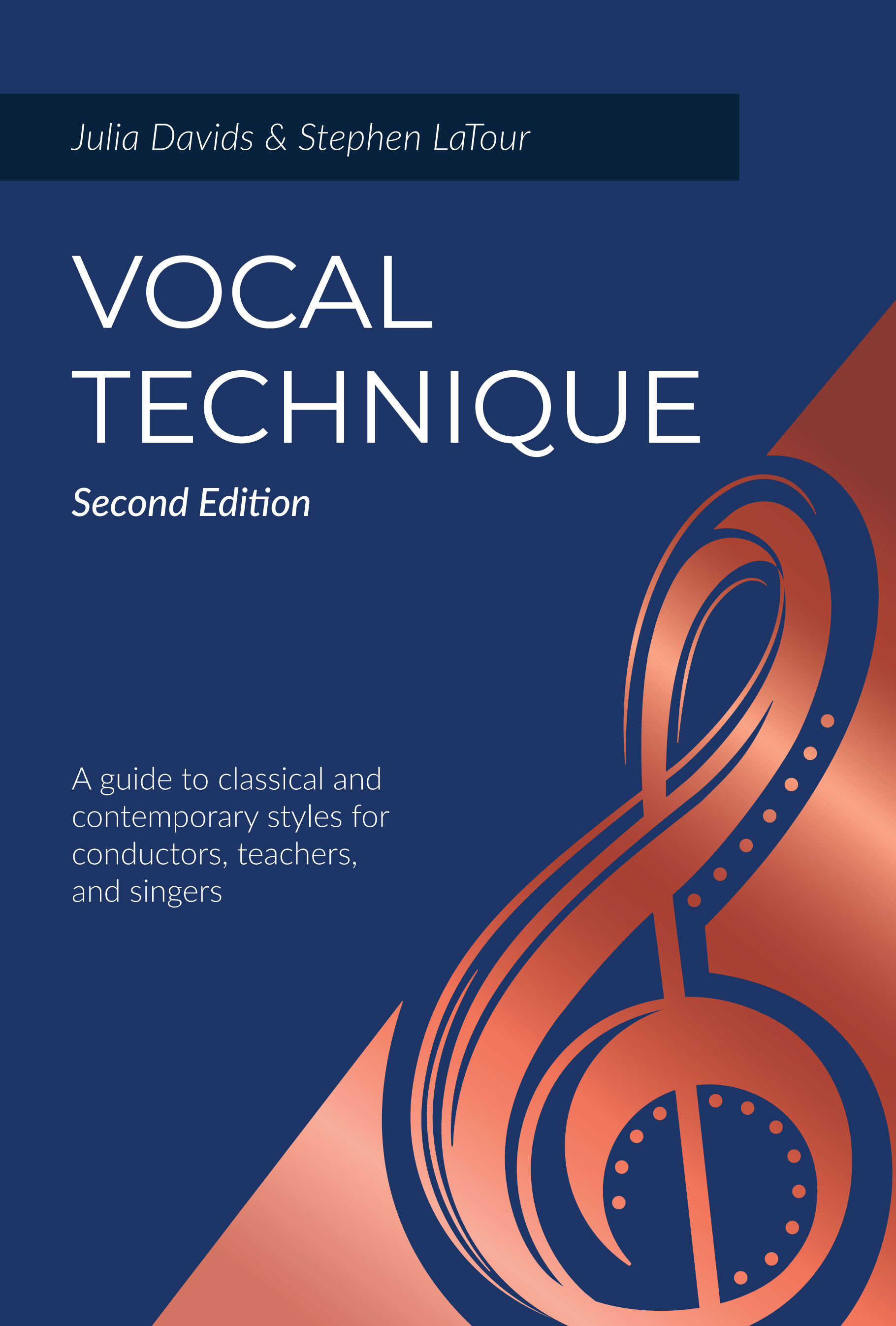“I think it is absolutely great! It is very accessible and my students really liked it. Also, it is affordable. Thank you!” — Christian Morren, Cameron University
“The Second Edition of Vocal Technique embraces 21st-Century perspectives for healthy voice training across all styles including classical, choral, and CCM. It acknowledges and credits commonalities and differences in variable resonance strategies, style implications for vibrato, children’s registers, differences in chest and head voice use according to style, registration for men and women, the transgender voice, and more on the voice during adolescence. It retains its clean, well-thought-out organization with clear, to-the-point illustrations. This is a resource independent and academic voice teachers and choral directors need!” — Karen Brunssen, Northwestern University and President, National Association of Teachers of Singing
“Davids and LaTour have constructed a comprehensive, research-based resource that draws singers, voice teachers, choral directors, and choral music educators into the same space around common principles related to vocal technique. The authors provide detailed explanations of key concepts, along with relevant strategies and best practices for engaging and supporting diverse populations of singers. This guide makes a substantial contribution to the field of vocal music and will assuredly enhance the work of singers and educators alike.” — Rollo A. Dilworth, Temple University and author, Choir Builders
“This book is a must-have for singers, teachers, and conductors of all styles. The content is well organized, backed by science, and explained with practical exercises. Best of all, it covers all styles of singing with plenty of resources to explore. A perfect book for entering the world of evidence-based voice pedagogy, with plenty for the experienced teacher to digest as well.” — Matthew Edwards, Shenandoah Conservatory and Artistic Director, CCM Vocal Pedagogy Institute

331 pages, $47.95 list
1-4786-4022-7
978-1-4786-4022-6
© 2021
paperback
eBook availability
Vocal Technique
A Guide to Classical and Contemporary Styles for Conductors, Teachers, and Singers
Second Edition
Vocal Technique is a practical, easy-to-read guide to better singing. This new edition offers a stylistically flexible approach that allows soloists and choral singers to vary the elements of technique to sing virtually any style—classical through contemporary (musical theatre, pop/rock, jazz, and more). It is a comprehensive yet concise book covering all aspects of technique, including body alignment, breath control, initiation of sound, vocal fold closure, resonance, register use, vowels, pitch control, articulation, and vibrato. It also features expanded treatment of vocal health and development. Conductors and teachers will appreciate the numerous practical exercises. Grounded in the latest pedagogical and scientific research, Vocal Technique, Second Edition will expand the horizons of both amateur and professional singers.
Online/remote instruction adaptability: The current lack of face-to-face instruction and rehearsals poses unique challenges for voice teachers and choral conductors. Vocal Technique, Second Edition can fill the void by offering an opportunity to focus on students’ individual vocal development and ensemble singing goals. Instructors can move through each chapter with their students, delving more deeply into the building blocks of singing (breathing, onset, vowels, resonance, registers) and exploring important ensemble-singing skills such as tone variation, how to vary vibrato, and intonation. Numerous specific and practical exercises support improved personal and group vocal technique for singers of all stages and styles.
Online/remote instruction adaptability: The current lack of face-to-face instruction and rehearsals poses unique challenges for voice teachers and choral conductors. Vocal Technique, Second Edition can fill the void by offering an opportunity to focus on students’ individual vocal development and ensemble singing goals. Instructors can move through each chapter with their students, delving more deeply into the building blocks of singing (breathing, onset, vowels, resonance, registers) and exploring important ensemble-singing skills such as tone variation, how to vary vibrato, and intonation. Numerous specific and practical exercises support improved personal and group vocal technique for singers of all stages and styles.
Reactions
Introduction: A Guide to Stylistically Flexible Vocal Technique
1. Posture/Alignment
2. Breath Control
3. Initiation, Creation, and Release of Sound
4. Resonance
5. Vowels
6. Consonants
7. Vibrato
8. Negotiation of the Vocal Registers
9. Voice Classification and Improving Range
10. Improving Intonation
11. Legato, Staccato, Accents, Melismas/Riffs, Dynamic Control, and Special Vocal Effects
12. Improving Choral Blend
13. Changing Voices
14. Reducing Tension
15. Guarding Singers’ Vocal Health
16. A Productive Warm-Up
Appendix: IPA Symbols for Important Vowels and Consonants
1. Posture/Alignment
2. Breath Control
3. Initiation, Creation, and Release of Sound
4. Resonance
5. Vowels
6. Consonants
7. Vibrato
8. Negotiation of the Vocal Registers
9. Voice Classification and Improving Range
10. Improving Intonation
11. Legato, Staccato, Accents, Melismas/Riffs, Dynamic Control, and Special Vocal Effects
12. Improving Choral Blend
13. Changing Voices
14. Reducing Tension
15. Guarding Singers’ Vocal Health
16. A Productive Warm-Up
Appendix: IPA Symbols for Important Vowels and Consonants